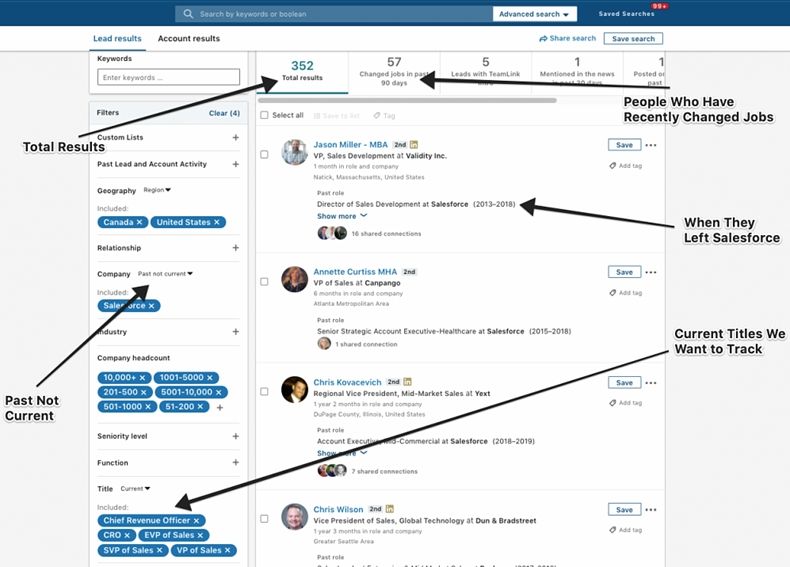Companies obsess over all the different types of cold outreach—cold-calling, cold email, cold social outreach, and others. But, as marketers, what do we really want?
We want warm leads. That's why we run webinars, produce content, and develop in-depth marketing funnels. Warm leads always out-convert cold leads for one reason: familiarity with your company.
So, how do you find those warm leads who already know you? One of the easiest ways is to track the movement of contacts in and out of your client base.
By targeting those buyers, we've seen the following outbound marketing statistics:
- 35-60% open rates
- 10-30% clickthrough rates
- 3X+ meeting rates compared with cold outreach
For example, let's assume your company sells compliance software and one of your largest clients is Starbucks. If you were to look back over the past three years, how many people would you find who began in Compliance at Starbucks and then left the company for another? And how many of those people are still in Compliance at their new company and could buy from you again?
If you have no idea, it's because you're not tracking buyer movement in and out of your client organizations. You probably have hundreds, if not thousands, of such people if your company has been in business for 3+ years.
More people are changing jobs than ever before
There is now a higher percentage of buyer movement from job to job than ever before. You must therefore put a systematic plan in place to find and track buyers who know and love your brand.
In July 2020 more than 5,000 C-suite executives at companies with more than 1,000 employees went on to accept new jobs, our tracking at Buyermovement.com has found. (We use a combination of custom emails, phone calls, and LinkedIn outreach program.)
Why are these leads particularly warm?
If you have a sales team doing cold outreach, tracking buyer movement should always be a priority.
Why? Because your sales team will have much more success targeting those warm leads with the right job title and the right company than they will targeting cold leads with the right job title at the right company.
Here's what we at OutboundView have found when tracking down and providing outreach to buyer-movement leads:
- Buyers who have moved within the past year are the most likely to take a meeting with your sales team.
- During outbound sales campaigns, these buyers are 3X as likely to engage in a conversation.
- These buyers open emails at 2X the rate of cold emails, and they click emails at 3X the rate of cold emails.
- These buyers are 2-3X more likely to move to the next stage of your sales process than a cold lead is.
- These leads don't even have to be familiar with your work to show interest. The fact that you're mentioning their previous employer is enough to start the conversation.
How do you find these leads?
Thankfully, there are systematic ways to track down buyers who have left your existing clients. Unfortunately, most of those methods are manual and take a good amount of research.
For example, you can use LinkedIn's Sales Navigator. Below is a sample search you could use, assuming your client were Salesforce and your target personas were in sales leadership in the US/Canada at companies with more than 200 employees.
You'll need to run a similar search for all your current and past clients.
The tedious part is identifying the people who've moved recently, within the past year, for example; they will be warmer, more relevant leads than those who left your clients 10 years ago.
The easiest and most sensible way to expedite the research process is to hire a team externally—i.e., outside the US. You can easily find research teams overseas that can take on this type of project for $8-15 an hour.
In addition to LinkedIn, there are a few of other sources you'll want to consider pulling contacts from:
- Your CRM: You'll want to track down any contacts/leads associated with your existing clients.
- Marketing automation: Are you getting drop-off on your marketing automation lists? It's probably because they no longer have the work email they originally provided.
- User lists: At some companies, end-users can be the buyers. If someone deactivates, that's a good sign that person has left that company.
We tracked buyer movement for a recent sales training company, and the results are below. As you can see, it's a lot of research time, but the company now has 9,200 warm leads to target.
![]()
Once you find these leads, the approach is straightforward: Use a combination of emails, phone calls, and LinkedIn outreach tactics. OutboundView has developed a detailed step-by-step guide on how to run this process on your own. Reach out if you have any questions on the process.
* * *
Every organization is different, but you'll always be looking for the warmest leads possible. Contacts who've worked for your clients and are now at other companies where they could purchase from you again will always outperform cold leads.





